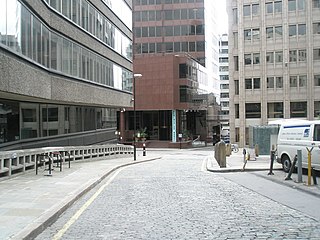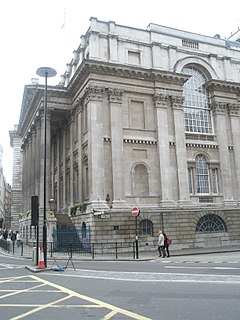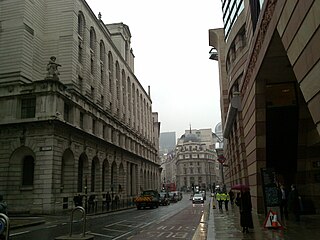
Pudding Lane is a small street in London widely known as the location of Thomas Farriner's bakery where the Great Fire of London started in 1666. It is off Eastcheap, near London Bridge and the Monument, in the historic City of London.

St Mary-le-Bow is a historic church rebuilt after the Great Fire of 1666 by Sir Christopher Wren in the City of London on the main east–west thoroughfare, Cheapside. According to tradition a true Cockney must be born within earshot of the sound of Bow Bells.

St Peter upon Cornhill is an Anglican church on the corner of Cornhill and Gracechurch Street in the City of London of medieval origin. It was destroyed in the Great Fire of London in 1666 and rebuilt to the designs of Sir Christopher Wren. It is now a satellite church in the parish of St Helen's Bishopsgate. It lies in the ward of Cornhill.

The Wood Street Compter was a small prison within the City of London in England. It was primarily a debtors' prison, and also held people accused of such misdemeanours as public drunkenness, although some wealthier prisoners were able to obtain alcohol through bribery. The prison was built and opened in 1555, replacing the earlier Bread Street Compter, from which many prisoners were transferred. Wood Street was closed and replaced by Giltspur Street Compter in 1791.

Gresham Street is a street in the City of London named after the English merchant and financier Thomas Gresham.

St Benet Fink was a church and parish in the City of London located on what is now Threadneedle Street. Recorded since the 13th century, the church was destroyed in the Great Fire of London of 1666, then rebuilt to the designs of Sir Christopher Wren. The Wren church was demolished between 1841 and 1846.

St Mary Bothaw was a parish church in the Walbrook ward of the City of London. It was destroyed in the Great Fire of London in 1666 and not rebuilt, although some of its materials were used in the rebuilding of St Swithin, London Stone, whose parish it was merged with.

St Mildred, Poultry was a parish church in the Cheap ward, of the City of London. It was rebuilt after the Great Fire of London and demolished in 1872. St Mildred in the Poultry was the burial place of the writer Thomas Tusser. Some description of the church and its monuments is given in John Stow's Survey of London.

St Nicholas Acons was a parish church in the City of London. In existence by the late 11th century, it was destroyed during the Great Fire of London of 1666 and not rebuilt.

All Hallows, Honey Lane was parish church in the City of London, England. Of medieval origin, it was destroyed in the Great Fire of London in 1666 and not rebuilt; the site became part of Honey Lane Market, which was in turn cleared to make way for the City of London School in the 19th century.

St Mary Colechurch was a parish church in the City of London destroyed in the Great Fire of London in 1666 and not rebuilt.

St Gabriel Fenchurch was a parish church in the Langbourn Ward of the City of London, destroyed in the Great Fire of London and not rebuilt.
St Mary Magdalen, Milk Street, was a parish church in the City of London, England. It was destroyed in the Great Fire of London in 1666 and not rebuilt.

St Michael-le-Querne, also called St Michael ad Bladum, was a parish church in the Farringdon Within Ward in the City of London. It was destroyed in the Great Fire of London of 1666 and not rebuilt. The name is apparently a reference to a quern-stone as there was a corn market in the churchyard.

St Pancras, Soper Lane, was a parish church in the City of London, in England. Of medieval origin, it was destroyed in the Great Fire of London in 1666 and not rebuilt.

St Martin Pomeroy was a parish church in the Cheap ward of the City of London. It was also known as St Martin Ironmonger Lane.

St Mary Woolchurch Haw was a parish church in the City of London, destroyed in the Great Fire of London of 1666 and not rebuilt. It came within the ward of Walbrook.

Poultry is a short street in the City of London, the historic nucleus and modern financial centre of London. It is an eastern continuation of Cheapside, between Old Jewry and Mansion House Street, towards Bank junction.

Milk Street in the City of London, England, was the site of London's medieval milk market. It was the location of the parish church of St Mary Magdalen which was destroyed in the Great Fire of London in 1666 and then of Honey Lane Market and the City of London School. The street was seriously damaged by German bombing during the Second World War and has since been completely rebuilt. Nothing remains of its former buildings.

Honey Lane Market was an historic market near Cheapside in the City of London.



















